Music
Trailers
DailyVideos
India
Pakistan
Afghanistan
Bangladesh
Srilanka
Nepal
Thailand
StockMarket
Business
Technology
Startup
Trending Videos
Coupons
Football
Search
Download App in Playstore
Download App
Best Collections
Technology

SpaceX has won the launch contract for NASA2022 mission to explore the mineral-rich asteroid known as Psyche, the space agency announced today, including launch services and other mission-related costs valued at $117 million — remarkably low for a mission of this scale.
The Psyche mission will use a Falcon Heavy rocket, which will launch from Launch Complex 39A at Cape Canaveral Air Force Station.
Located between Mars and Jupiter, the Psyche asteroid is made of the exposed nickel-iron core of an early planet and represents a fragment of one of the earliest building blocks of our solar system.
NASA is hoping that the exploration of Psyche will yield clues about the history of the evolution of terrestrial planets through the examination of Psycheown proto-planetary material.
The space agencyPsyche mission includes two secondary payloads: The Escape and Plasma Acceleration and Dynamics Explorers, which will study the atmosphere on Mars, and the Janus mission, which will study binary asteroids.
NASA said its Launch Services Program at Kennedy Space Center in Florida will manage the SpaceX launch service and that the mission is led by Arizona State University .
&With the transition into this new mission phase, we are one big step closer to uncovering the secrets of Psyche, a giant mysterious metallic asteroid, and that means the world to us,& said principal investigator Lindy Elkins-Tanton of Arizona State University in Tempe, in a statement when NASA announced that it was approving the mission.
Pasadena, Calif.Jet Propulsion Laboratory will be the overall manager for the mission, including system engineering, integration, testing and mission operations. The spacecraftpropulsion chassis is a high-power solar electric rig provided by Maxar Space Solutions.
This announcement clears the way for Phases D, E, and F of the Psyche mission — the final official phases before launch.
As we wrote last year:
Phase D will begin in early 2021, and includes the final manufacturing and testing of the spacecraft along with the planned launch in early 2022.
Phase E will happen as soon as Psycheexploratory craft hits the vacuum of space, NASA said. It&ll cover the deep space operations of the mission and the collection of data for science. NASA expects Psyche will arrive at its eponymous asteroid on January 31, 2026 after buzzing Mars in 2023 (two years beforeElon Muskpredicted the first human astronauts would arrive).
Instruments on the Psyche craft will include a magnetometer designed to detect and measure the remnant magnetic field of the asteroid. A multi-spectral imager will be on board to provide high-resolution images to determine the composition of the asteroid (how much is metal versus how much is a silicate). The craft will also include a gamma ray and neutron spectrometer to detect, measure and map the asteroidelemental composition, and a new laser technology thatdesigned for deep space communications.
- Details
- Category: Technology Today
Read more: SpaceX wins the $117 million launch contract to explore Psyche’s heavy metal asteroid
Write comment (96 Comments)An iPhone app built by controversial facial recognition startup Clearview AI has been blocked by Apple, effectively banning the app from use.
Apple confirmed to TechCrunch that the startup &violated& the terms of its enterprise developer program.
The app allows its users — which the company claims it serves only law enforcement officers — to use their phone camera or upload a photo to search its database of 3 billion photos. But BuzzFeed News revealed that the company — which claims to only cater to law enforcement users — also includes many private-sector users, including Macy&s, Walmart and Wells Fargo.
Clearview AI has been at the middle of a media — and legal — storm since its public debut in The New York Times last month. The company scrapes public photos from social media sites, drawing ire from the big tech giants that claim Clearview AI misused their services. But italso gained attention from hackers. On Wednesday, Clearview AI confirmed a data breachin which its client list was stolen.
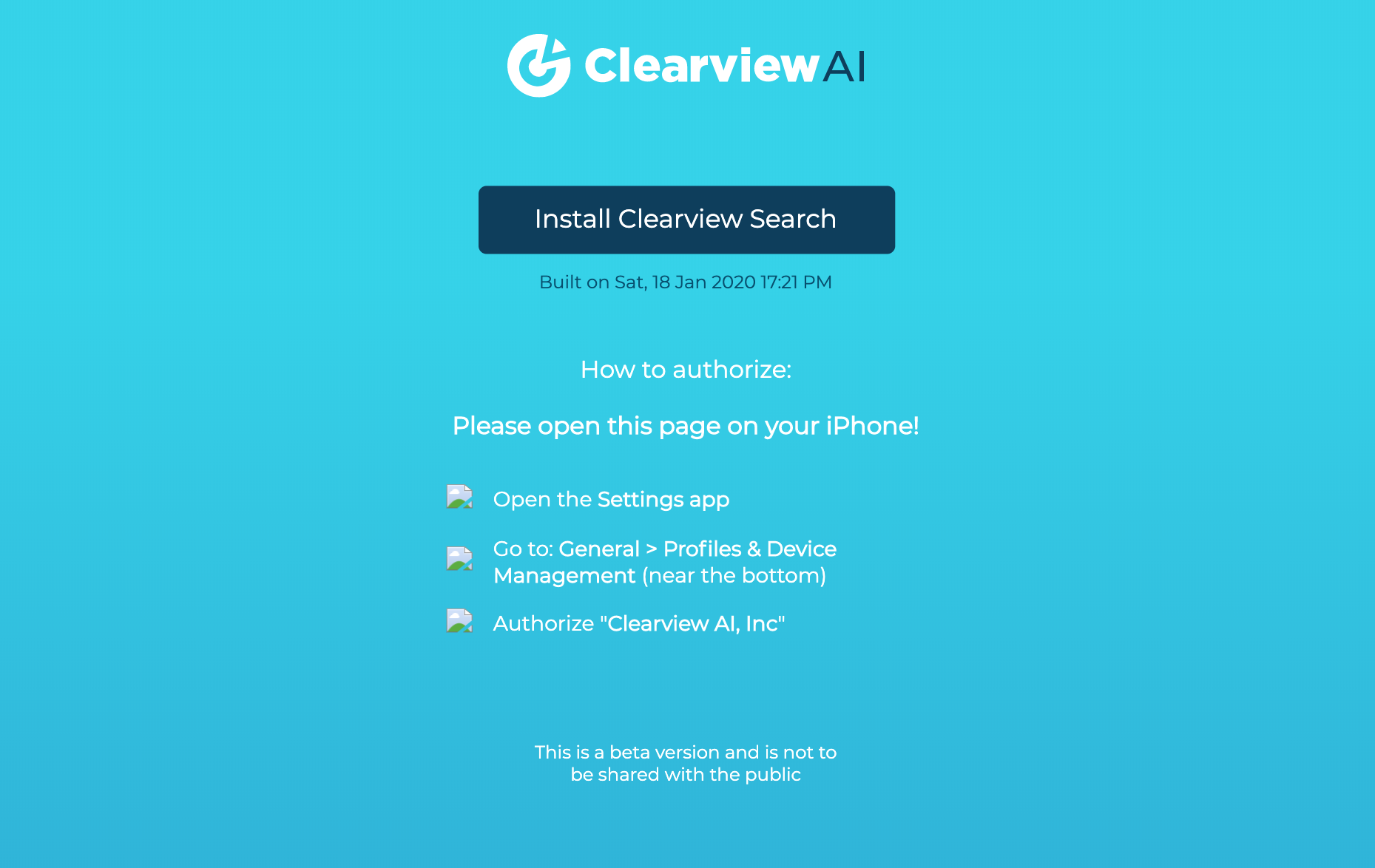
The public Amazon S3 page containing the iPhone app (Image: TechCrunch)
TechCrunch found Clearview AIiPhone app on an public Amazon S3 storage bucket on Thursday, despite a warning on the page that the app is ¬ to be shared with the public.&
The page asks users to &open this page on your iPhone& to install and approve the companyenterprise certificate, allowing the app to run.
But this, according to Applepolicies, is prohibited if the appusers are outside of Clearview AIorganization.
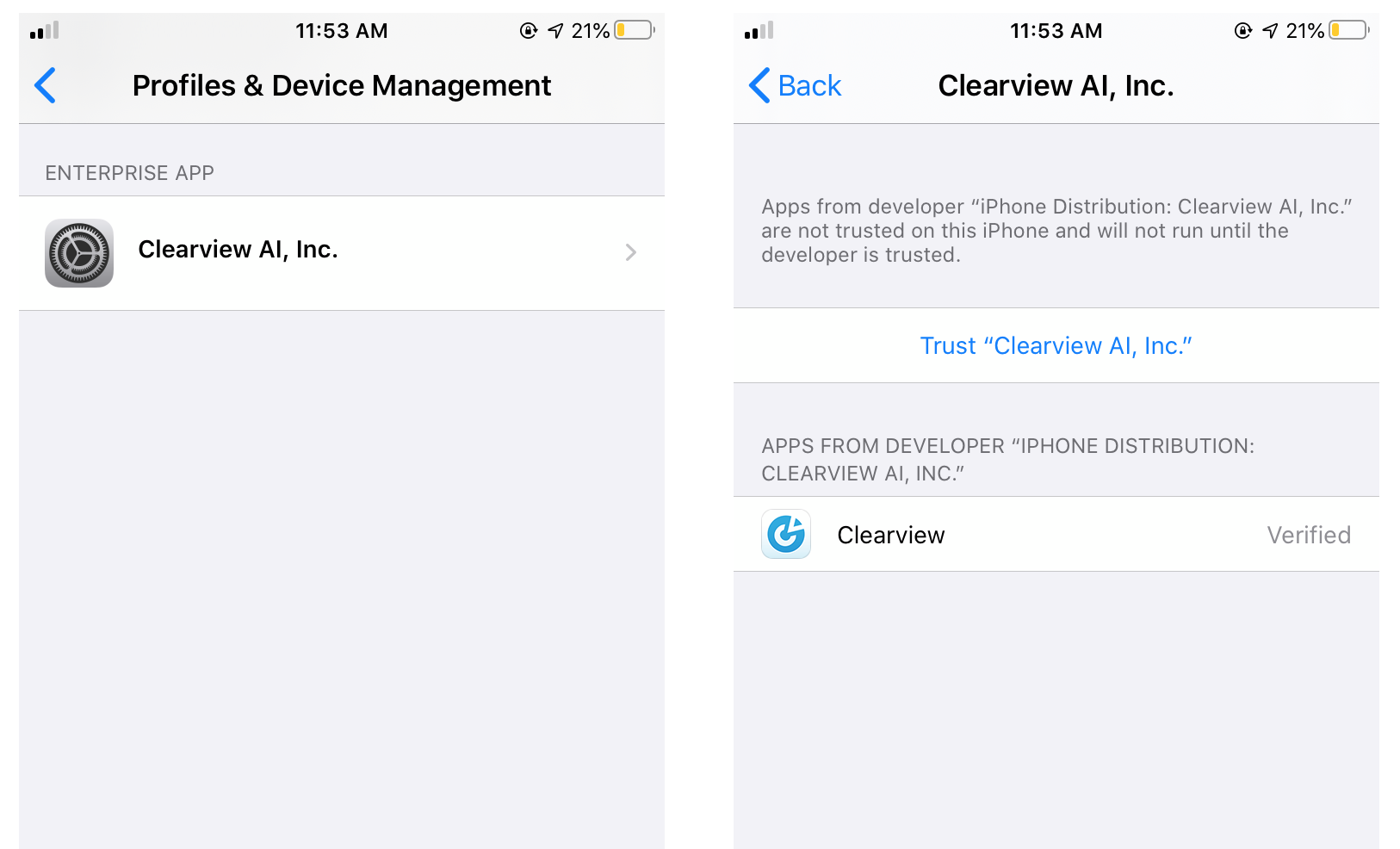
Clearview AIuse of an enterprise certificate on an iPhone (Image: TechCrunch)
Enterprise certificates are issued by Apple to allow companies to build and approve iPhone and iPad apps designed for internal company use only. Itcommon for these certificates to be used to test apps internally before they are pushed out to the App Store. Apple maintains a strict set of rules on use of enterprise certificates, and says they cannot be used by consumers. But there have been cases of abuse.
Last year, TechCrunch exclusively reported that both Facebook and Google were using their enterprise certificates for consumer-facing apps in an effort to bypass AppleApp Store. Apple revoked the tech giants& enterprise certificates, disabling the infracting app but also any other app that relied on the certificate, including their catering and lunch menu apps.
The app was labeled as &beta& — typically a pre-release or a test version of the app. Besides this claim, there is no evidence to suggest this app was not used by Clearview AI customers.
Clearview AI chief executive Hoan Ton-That told TechCrunch: &We are in contact with Apple and working on complying with their terms and conditions.&
A brief analysis of the app through network traffic tools and disassembly tools shows it works largely in the same way as Clearview AIAndroid app, which was discovered by Gizmodo on Thursday.
Like the Android app, a user needs a Clearview AI-approved username and password to use the app.
- Details
- Category: Technology Today
Read more: Apple has blocked Clearview AI’s iPhone app for violating its rules
Write comment (95 Comments)
The &Sent viaSuperhuman iOS& email signature has become one of the strangest flexes in the tech industry, but its influence is enduring, as the $30 per month invite-only email app continues to shape how a wave of personal productivity startups are building their business and product strategies.
I had a chance to chat with Superhuman CEO and founder Rahul Vohra earlier this month during an oddly busy time for him. He had just announced a dedicated $7 million angel fund with his friend Todd Goldberg (which I wrote up here) and we also noted that LinkedIn is killing off Sales Navigator, a feature driven by Rapportive, which Vohra founded and later sold in 2012. All the while, his buzzy email company is plugging along, amassing more interested users. Vohra tells me there are now more than 275,000 people on the waitlist for Superhuman.
Below is a chunk of my conversation with Vohra, which has been edited for length and clarity.
TechCrunch: When you go out to raise funding and a chunk of your theoretical user base is sitting on a waitlist, is it a little tougher to determine the total market for your product?
Rahul Vohra: Thata good question. When we were doing our Series B, it was very easily answered because we&re one of a cohort of companies, that includes Notion and Airtable and Figma, where the addressable market — assuming you can build a product thatgood enough — is utterly enormous.
With my last company, Rapportive, there was a lot of conversation around, &oh, whatthe business model? Whatthe market? How many people need this?& This almost never came up in any fundraising conversation. People were more like, &well, if this thing works, obviously the market is basically all of prosumer productivity and that is, no matter how you define it, absolutely huge.&
- Details
- Category: Technology Today
Read more: Superhuman CEO Rahul Vohra on waitlists, freemium pricing and future products
Write comment (92 Comments)Chat bots were central to Facebook Messengerstrategy three years ago. Now they&re being hidden from view in the app along with games and businesses. Facebook Messenger is now removing the Discover tab as it focuses on speed and simplicity instead of broad utility like ChinaWeChat.
The changes are part of a larger Messenger redesign that reorients the People tab around Stories as Facebook continues to try to dominate the ephemeral social media format it copied from Snapchat. The People tab now defaults to a full-screen sub-tab of friends& Stories, and requires a tap over to the Active sub tab to see which friends are online now.
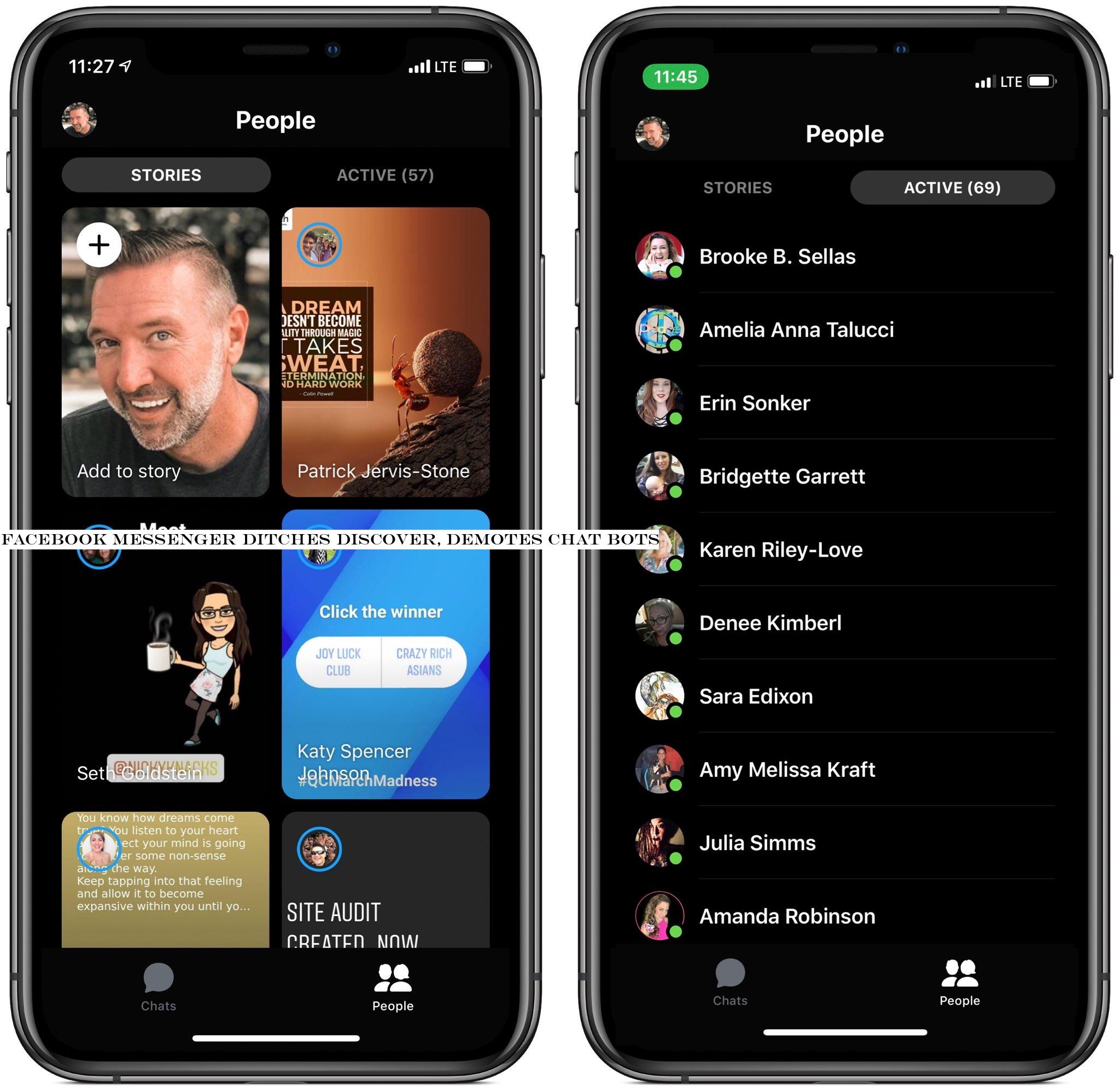
The changes could push users to spend more time visually communicating with friends and consuming content than exploring chat bots for shopping, connecting with businesses and playing games. That in turn could help Facebook earn more money from Messenger as itnow showing Stories ads.
TechCrunch was tipped off to the redesign by social media director Jeff Higgins, who provided us with extensive screenshots of the update. These show the absence of Discover tab, the switch to just Chat and People tabs and the People sub-tabs for Stories and Active. We poked around some more and noticed the Instant Games and Transportation options missing from the chat composerutility tray. That formerly offered quick Uber and Lyft hailing. MessengerM Suggestions also no longer recommend the Transportation feature.
When we asked Messenger about the changes, a spokesperson confirmed that this redesign will soon start rolling out, removing Discover and splitting the People tab. Some users already have the update, and more will likely get it this week. They noted that Facebook had announced last August that it planned to eventually axe Discover, and that the added emphasis on Stories was motivated by users& affinity for the ephemeral social media format. They also told us that Transportation was removed in late 2017, and Instant Games& removal from the composer is part of the migration to Facebook Gaming announced last July.
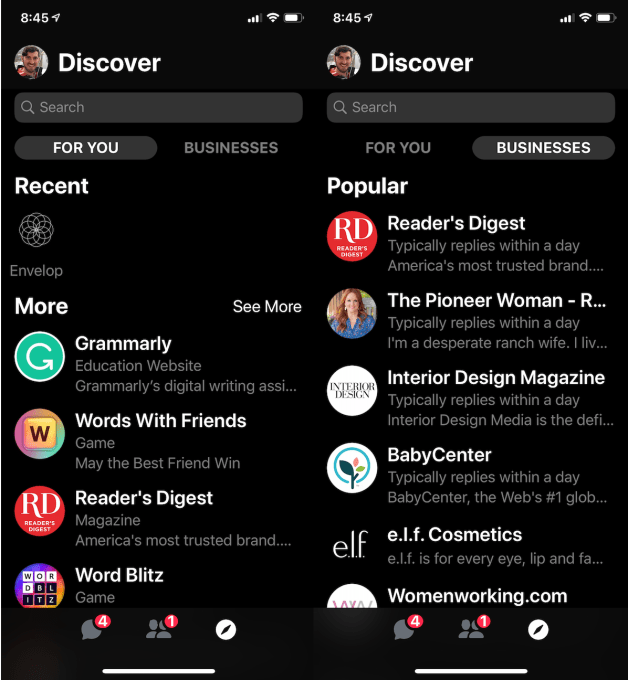
A look at the old Messenger Discover tab thatbeing removed
Chat bots, businesses and games are being hidden, but not completely banished from Messenger. They&ll still be accessible if users purposefully seek them through the Messenger search bar, Pages and ads on Facebook, buttons to start conversations on businesses& websites, and m.me URL that create QR codes which open to business accounts in Messenger. The spokesperson diplomatically claimed that businesses are still an important part of Messenger.
But without promotion via Discover, businesses will have to rely on their owned or paid marketing channels to gain traction for their chat bots. That could discourage them from building on the Messenger platform.
The rise and fall of Facebook chat bots
The update feels like the end of a four-year era for Facebook. Back in 2016, it saw artificially intelligent chat bots as a way for businesses to scalably communicate with people, deliver customer service and push e-commerce. But when it launched the chat bot platform at its F8 conference that year, it arrived half-baked.
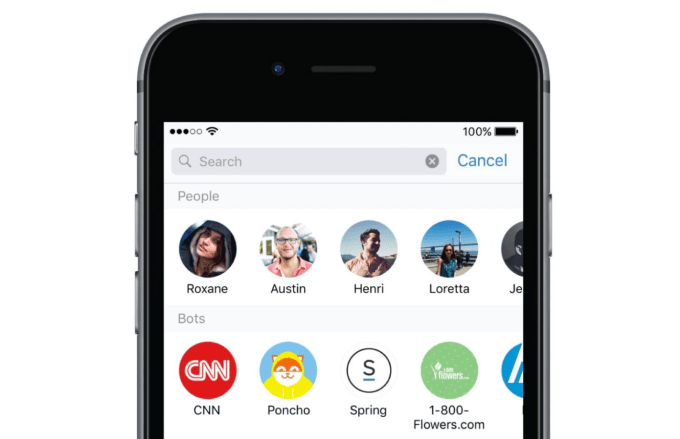
The typing-based semantic user interfaces were confusing, the AI necessary to make chat bots seem human (or at least reliably understand their human conversation partners hadn&t evolved yet) and several of the launch partner bots like Poncho The Weather Cat were laughably useless. The public soured on the idea of chat bots, and attempts to improve them felt insufficient.
Messenger launched Discover in 2017 in hopes that free promotion and visibility might convince developers to invest in building better chatbots. Yet by early 2018, even Facebook was backpedaling, shelving its plan to build out a full-service AI personal assistant called M that you could ask to do anything. Instead, it&d merely make AI suggestions of different Messenger features to use, like Stickers or reminders based on what you typed. Then it announced last year that it would move Instant Games out of Messenger and into Facebookdedicated Gaming tab.
There is still an opportunity to use chat bots for gathering initial info from people with sales or customer service inquiries. Everyone hates dealing with this stuff over the phone, waiting on hold and wading through touch-tone menus. Using asynchronous messaging makes communicating with businesses much more convenient. I&d bet Facebook will still be pushing this as an enterprise use case for Messenger. But this still usually requires a human in the loop at some point, and these are better structured as reactive utilities users search for than as experience proactively promoted by a Discover tab.

A laughably bad interaction with old Messenger chat bot Poncho The Weather Cat
Now with Discover disappearing, Messenger seems to be surrendering the fight to become a WeChat-style monolithic utility. In China, WeCat serves not just as a messaging app but as a way to make payments, hail a taxi, book flights, top up your mobile data, get a loan, find housing or shop at businesses via mini programs.
 But while that centralized all-in-one style fit Chinese culture, Western markets have experienced more of an unbundling with different apps emerging to handle each of these use cases. Facebookconstant privacy scandals and increasing anti-trust scrutiny also inhibited this approach with Messenger. Users and the U.S. government weren&t ready to trust Facebook to handle so much of our daily lives. Facebook Messenger also has to jockey with competition like iMessage and Snapchat that could undercut it if it gets too bloated.
But while that centralized all-in-one style fit Chinese culture, Western markets have experienced more of an unbundling with different apps emerging to handle each of these use cases. Facebookconstant privacy scandals and increasing anti-trust scrutiny also inhibited this approach with Messenger. Users and the U.S. government weren&t ready to trust Facebook to handle so much of our daily lives. Facebook Messenger also has to jockey with competition like iMessage and Snapchat that could undercut it if it gets too bloated.
So now Messenger is going in the opposite direction. Itbecoming more WhatsApp-like — simple, speedy and centered around peer-to-peer communication. Visual communication through Stories, with replies to them delivered as messages, feels like a natural extension of this focus while conveniently offering a path to monetization. If Messenger can be the best-in-class place to chat, unencumbered by promotion of chat bots and businesses, users might stay locked into the Facebook ecosystem.
- Details
- Category: Technology Today
Read more: Facebook Messenger ditches Discover, demotes chat bots
Write comment (94 Comments)The FCC has officially and finally determined that the major wireless carriers in the U.S. broke the law by secretly selling subscribers& location data for years with almost no constraints or disclosure. But its Commissioners decry the $208 million penalty proposed to be paid by these enormously rich corporations, calling it ¬ properly proportioned to the consumer harms suffered.&
Under the proposed fines, T-Mobile would pay $91M; AT-T, $57M; Verizon, $48M; and Sprint, $12M. (Disclosure: TechCrunch is owned by Verizon Media. This does not affect our coverage in the slightest.)
The case has stretched on for more than a year and a half after initial reports that private companies were accessing and selling real-time subscriber location data to anyone willing to pay. Such a blatant abuse of consumers& privacy caused an immediate outcry, and carriers responded with apparent chagrin — but often failed to terminate or even evaluate these programs in a timely fashion. It turns out they were run with almost no oversight at all, with responsibility delegated to the third party companies to ensure compliance.
Meanwhile the FCC was called on to investigate the nature of these offenses, and spent more than a year doing so in near-total silence, with even its own Commissioners calling out the agencylack of communication on such a serious issue.
Finally, in January, FCC Chairman Ajit Pai — who, it really must be noted here, formerly worked for one of the main companies implicated, Securus — announced that the investigation had found the carriers had indeed violated federal law and would soon be punished.
Today brings the official documentation of the fines, as well as commentary from the Commission. In the documents, the carriers are described as not only doing something bad, but doing it poorly — and especially in T-Mobilecase, continuing to do it well after they said they&d stop:
We find that T-Mobile apparently disclosed its customers& location information, without their consent, to third parties who were not authorized to receive it. In addition, even after highly publicized incidents put the Company on notice that its safeguards for protecting customer location information were inadequate, T-Mobile apparently continued to sell access to its customers& location information for the better part of a year without putting in place reasonable safeguards—leaving its customers& data at unreasonable risk of unauthorized disclosure
The general feeling seems to be that while itcommendable to recognize this violation and propose what could be considered substantial fines, the whole thing is, as Commissioner Rosenworcel put it, &a day late and a dollar short.&
The scale of the fines, they say, has little to do with the scale of the offenses — and thatbecause the investigation did not adequately investigate or attempt to investigate the scale of those offenses. As Commissioner Starks writes in a lengthy statement:
After all these months of investigation, the Commission still has no idea how many consumers& data was mishandled by each of the carriers.
We had the power—and, given the length of this investigation, the time—to compel disclosures that would help us understand the true scope of the harm done to consumers. Instead, the Notices calculate the forfeiture based on the number of contracts between the carriers and location aggregators, as well as the number of contracts between those aggregators and third-party location-based service providers. That is a poor and unnecessary proxy for the privacy harm caused by each carrier, each of which has tens of millions of customers that likely had their personal data abused.
Essentially, the FCC didn&t even look at the number or nature of actual harm — it just asked the carriers to provide the number of contracts entered into. As Starks points out, one such contract can and did sometimes represent thousands of individual privacy invasions.
We know there are many—perhaps millions—of additional victims, each with their own harms. Unfortunately, based on the investigation the FCC conducted, we don&t even know how many there were, and the penalties we propose today do not reflect that impact.
And why not go after the individual companies? Securus, Starks says, &behaved outrageously.& But they&re not being fined at all. Even if the FCC lacked the authority to do so, it could have handed off the case to Justice or local authorities that could determine whether these companies violated other laws.
As Rosenworcel notes in her own statement, the fines are also extraordinarily generous even beyond this minimal method of calculating harm:
The agency proposes a $40,000 fine for the violation of our rules—but only on the first day. For every day after that, it reduces to $2,500 per violation. The FCC heavily discounts the fines the carriers potentially owe under the law and disregards the scope of the problem. On top of that, the agency gives each carrier a thirty-day pass from this calculation. This thirty day &get-out-of-jail-free& card is plucked from thin air.
Given that this investigation took place over such a long period, itstrange that it did not seek to hear from the public or subpoena further details from the companies facilitating the violations. Meanwhile the carriers sought to declare a huge proportion of their responses to the FCCquestions confidential, including publicly available information, and the agency didn&t question these assertions until Starks and Rosenworcel intervened.
$200M sounds like a lot, but divided among several billion-dollar communications organizations itpeanuts, especially when you consider that these location-selling agreements may have netted far more than that in the years they were active. Only the carriers know exactly how many times their subscribers& privacy was violated, and how much money they made from that abuse. And because the investigation has ended without the authority over these matters asking about it, we likely never will know.
The proposed fines, called a Notice of Apparent Liability, are only a tentative finding, and the carriers have 30 days to respond or ask for an extension — the latter of which is the more likely. Once they respond (perhaps challenging the amount or something else) the FCC can take as long as it wants to come up with a final fine amount. And once that is issued, there is no requirement that the fine actually be collected — and the FCC has in fact declined to collect before once the heat died down, though not with a penalty of this scale.
&While I am glad the FCC is finally proposing fines for this egregious behavior, it represents little more than the cost of doing business for these carriers,& Congressman Frank Pallone (D-NJ) said in a statement. &Further, the Commission is still a long way from collecting these fines and holding the companies fully accountable.&
The only thing that led to this case being investigated at all was public attention, and apparently public attention is necessary to ensure the federal government follows through on its duties.
(This article has been substantially updated with new information, plus comments from Commissioner Starks and Rep. Pallone.)
- Details
- Category: Technology Today
Read more: FCC proposes $208M in fines for wireless carriers that sold your location for years
Write comment (91 Comments)Facebook first showed off its 3D photos back in 2018, and shared the technical details behind it a month later. But unless you had one of a handful of phones with dual cameras back then (when they weren&t so common), you couldn&t make your own. Today an update brings 3D photos to those of us still rocking a single camera.
In case you don&t remember or haven&t seen one lately, the 3D photos work by analyzing a 2D picture and slicing it into a ton of layers that move separately when you tilt the phone or scroll. I&m not a big fan of 3D anything, and I don&t even use Facebook, but the simple fact is this feature is pretty cool.

The problem is it used the dual-camera feature to help the system determine distance, which informed how the picture should be sliced. That meant I, with my beautiful iPhone SE, was out of the running — along with about a billion other people who hadn&t bought into the dual-camera thing yet.
But over the last few years the computer vision team over at Facebook has been working on making it possible to do this without dual-camera input. At last they succeeded, and this blog post explains, in terms technical enough that I&m not even going to attempt to summarize them here, just how they did it.
The advances mean that many — though not all — relatively modern single-camera phones should be able to use the feature. GooglePixel series is now supported, and single-camera iPhones from the 7 forward. The huge diversity of Android devices makes it hard to say which will and won&t be supported — it depends on a few things not usually listed on the spec sheet — but you&ll be able to tell once your Facebook app updates and you take a picture.
- Details
- Category: Technology Today
Read more: Facebook brings its 3D photos feature to users with single-camera phones
Write comment (91 Comments)Page 1332 of 1412

 8
8





